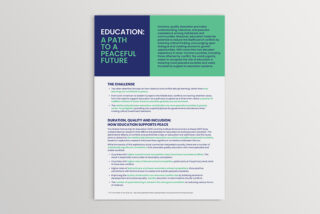The Global Partnership for Education (GPE), in collaboration with the Institute for Economics & Peace (IEP), have released a ground breaking report which provides compelling evidence of the strong relationship between education and peace. Released to coincide with the International Day of Education, the Education and Peace Briefing includes comprehensive data analysis demonstrating how educational improvements are closely linked to higher levels of peacefulness in societies worldwide.
The first edition of the Education and Peace Briefing reveals a pivotal connection between education and substantial reductions in levels of global conflict and violence. The comprehensive analysis, drawing on extensive data, uncovers how enhancements in education not only help reduce the intensity and occurrence of internal conflict and violence, but help to build long term and sustainable peace. Education is also a powerful tool for promoting tolerance and respect across diverse communities, laying the foundations for enduring global peace and prosperity
The report includes detailed country profiles, illustrating how individual nations have improved their peace standings through educational reforms and investment.
Timor Leste’s transition from conflict to stability, marked by UN peacekeepers’ withdrawal in 2012 and peaceful elections up to 2022, aligned with educational improvements. Lower secondary school completion rates increased from 67% in 2015 to 91% by 2022. This educational progress, supported by over $32 million from the Global Partnership for Education, suggests a strong correlation between educational development and peace in the country.
Nepal adopted a new constitution in 2015, transitioning to democracy post the civil war which ended in 2000. Over the last 20 years, the country significantly increased its education spending, focusing on learning outcomes and equitable access. This aligned with improved secondary school completion rates and a 30-place rise in global peace rankings since 2008, attributed mainly to reduced internal conflict. With $236 million in support from the Global Partnership for Education since 2009, these educational investments have coincided with substantial improvements in its ongoing conflict score in the Global Peace Index.
There is a need for governments and international organisations to prioritise education in their policy frameworks. This should involve strategic investments in educational initiatives, particularly targeting regions and demographics that currently lag in educational achievement. Such focused efforts are essential for promoting global peace and stability, and as the report demonstrates, there is a clear link between educational advancement and peaceful societies.
